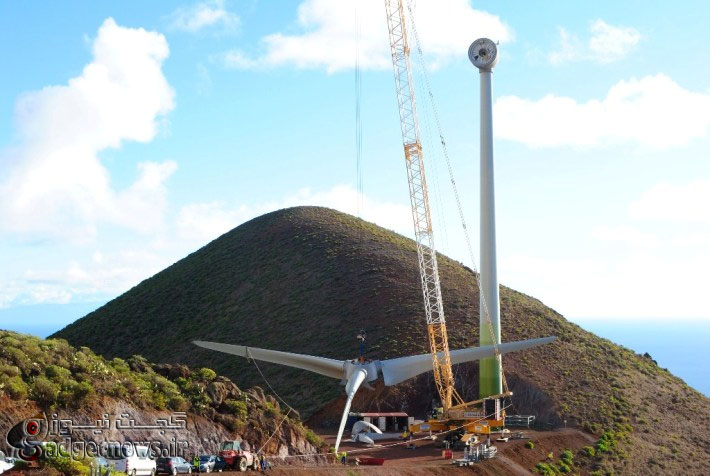
نخستین جزیره جهان که کاملا با نیروی آب و باد نیرودهی میشود، معرفی شد. خودکفایی در تولید نیروی برق آرزویی است که تمامی افراد دوستدار محیط زیست رؤیای آن را در سر میپرورانند و هم اکنون این جزیره با تولید آب و برق خود، چنین رؤیایی را به واقعیت تبدیل کرده است.
یک مزرعه بادی در اواخر ماه ژوئیه در El Hierro که کوچکترین جزیره قناری اسپانیا است، افتتاح میشود. این جزیره با صخرهها و کوههای شیبدارش برای برداشتکردن باد ورودی از آن سوی ساحل اقیانوس اطلس در آفریقا بسیار ایدهآل است.
پنج توربین نصبشده در نوار شمال شرقی El Hierro دارای بازدهی کلی 11.5 مگاوات خواهند بود که این میزان برای تامین نیاز برق 10 هزار سکنه جزیره و همچنین کارخانههای آب شیرینکن آن کفایت میکند.

گرچه جزایر دیگری در سراسر جهان با انرژی خورشیدی یا باد نیرودهی میشوند، کارشناسان بر این باورند این جزیره نخستین خشکی است که قادر به عرضه مداوم الکتریسیته با ترکیبکردن نیروی آب و باد و بدون اتصال به هیچ گونه شبکه الکتریسیته خارجی است.
نیروی اضافی توربینهای بادی برای پمپاژکردن آب شرب از مخزنی در نزدیکی بندر به مخزنی بزرگتر در دهانه برخورد آتشنشانی منتقل میشود که این دهانه 700 متر بالاتر از سطح دریا قرار دارد.زمانی هم که هیچ بادی وجود ندارد، آب از طریق توربینها برای تولید برق به مخزن پایینتری منتقل میشود.
مقاماتی از دانمارک، ژاپن، هاوایی و اندونزی به این مزرعه بادی علاقه نشان دادهاند.
منبع : endesa
El Hierro 100% Renewable
The El Hierro 100% Renewable project aims to design, develop, construct and bring online a hydro-wind power facility that is able to meet the electricity needs of El Hierro Island, making it self-sufficient using renewable energy exclusively. 50-80% of total demand will be met using renewable energy during the initial implementation phases.
Gorona del Viento S. A., made up of Cabildo de El Hierro (60%), Endesa (30%) the Government of the Canary Islands (10%), will manage the project. The name refers to the semicircular walls that farmers build on the island to protect their herds from the wind. The project involves an investment of €64.7 million, of which €35 million is being supplied by the Spanish Government’s Institute for Diversification and Energy Saving (IDAE).
The system will be made up of two reservoirs of water, a wind farm, a hydroelectric plant, a pumping station and a diesel powered facility (already in existence). The lower reservoir will have a capacity of up to 150,000 cubic meters of water, while the upper reservoir, which will take advantage of a natural volcanic caldera, will be able to store up to 556,000 cubic meters. The five turbine wind farm will have installed capacity of 11.5 MW; the hydroelectric plant, with four Pelton turbines will have installed capacity of 11.3 MW and the pumping plant 6 MW. The Llanos Blancos plant has installed capacity of 12.7 MW.
The hydro-wind power plant will transform an intermittent energy source into a controlled and continuous supply of electricity, taking full advantage of wind energy and incorporating it into the system. Most of the energy transferred to the island grid will come from the hydroelectric plant, and most of the wind energy will be used to feed the pumping system, and as such will be stored in the upper reservoir as potential energy. Surplus wind energy will be sent directly to the grid, for use in the two water desalination plants on El Hierro. The diesel powered facility will only be used in exceptional or emergency situations, when there is neither sufficient wind nor water to produce enough electricity to meet demand.
The facility is expected to lead to annual savings of 18,700 tonnes of CO2 emissions and €1.8 million resulting from no longer having to buy 40,000 barrels of petrol currently required. This project is a big step forward in the development of the island, which was declared a Biosphere Reserve by UNESCO in 2000 for the preservation of its environmental and cultural heritage and the progress and development sought by its population..
If the project is successful it will mean that similar facilities will be able to be used on other islands in the Canary archipelago, as well as providing a model that can be exported to other islands in throughout the world.
Sustainable mobility
In tandem with this energy project, Endesa and the Renault-Nissan Alliance have signed a Memorandum of Understanding with the El Hierro Council to encourage e-mobility. The agreement, which lasts until December 2012, aims to analyse the project's viability from a number of angles: technical, legal, economic, etc.
The Renault-Nissan Alliance will share its technological knowledge to set up a recharging system for its vehicles and has committed itself to manufacturing electrical vehicles the meet the islanders' requirements. Endesa will study the development, implementation and maintenance of a recharging network adapted to the territory's features and its energy capacity. The El Hierro Council has made a commitment to offer businesses and private individual’s incentives in the future to buy electric vehicles and help entities as necessary to ensure that sustainable mobility becomes a reality on the island.
 گجت نیوز آخرین اخبار تکنولوژی، علم و خودرو
گجت نیوز آخرین اخبار تکنولوژی، علم و خودرو 





